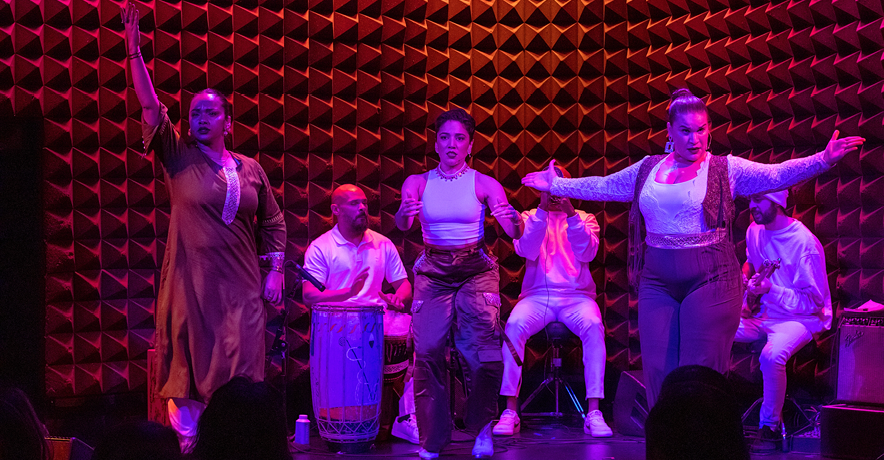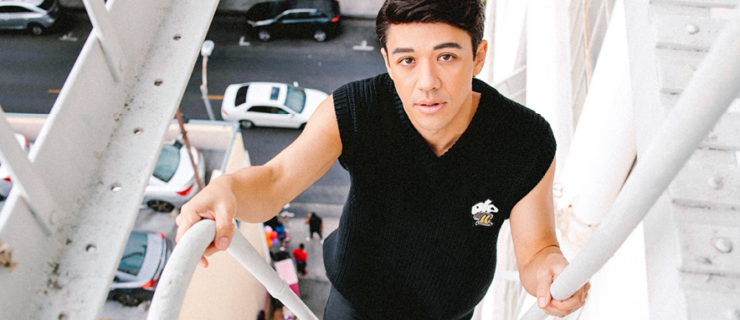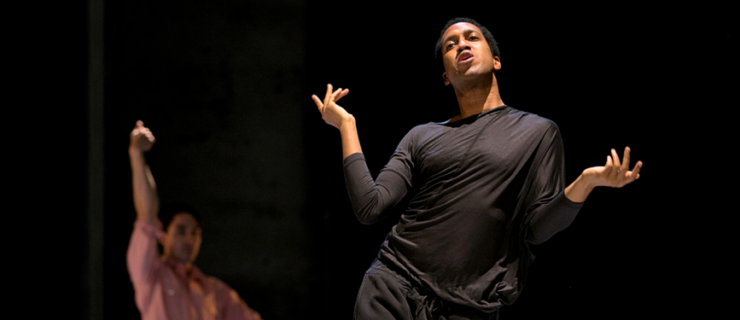Sole Sisters: The Cross-Cultural Collaboration Soles of Duende Offers Just the Kind of Art We Need Right Now
In any given Soles of Duende rehearsal, someone might ask for Greta. “When we are hitting walls or butting heads, we call ‘Greta, where are you?’ ” says dancer Amanda Castro.
Greta is not real. She’s the personification of the creative idea, as imagined by the Soles of Duende trio: Castro, Brinda Guha, and Arielle Rosales. Other times, a dancer might call out “parking lot,” to table an idea they don’t have time for, or “mangu,” which is the name of a mashed plantain dish and signals they’re too drained or overloaded to think clearly.
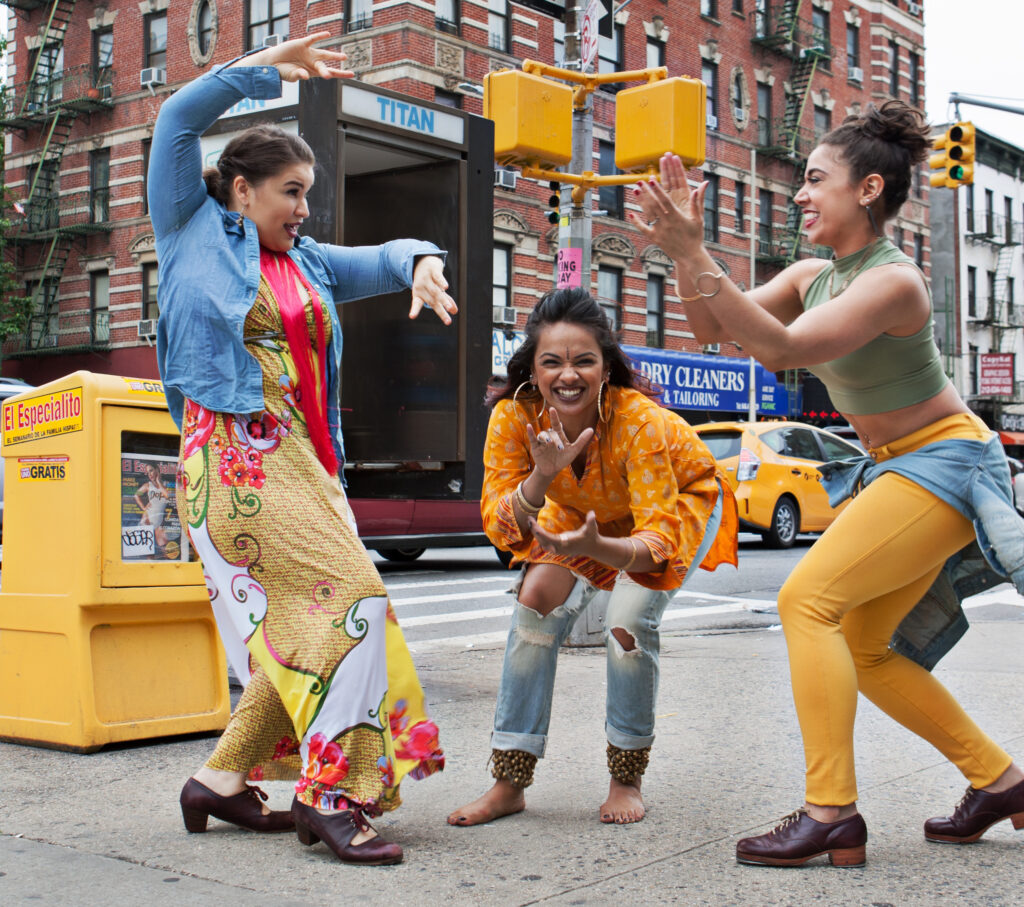
Any group develops their own lingo after spending hours together. But for three dancers working in different physical languages—kathak (Guha), flamenco (Rosales), and tap (Castro)—this shared verbal lexicon streamlines the creative process. “They don’t share the same style, but they share the same kind of creative energy,” says tap dancer Jason Samuels Smith, who recently worked with the trio during a residency at the Chelsea Factory in New York City. “Some collaborations can feel forced. But with them, you feel the chemistry, you feel the camaraderie.” And at a moment when cross-cultural conversations can feel fraught, these artists are showcasing the power of embracing our differences.
Distinct Voices in Harmony
Soles of Duende, or “Soles” as the dancers call it, started in 2016 when Guha and Rosales had an opportunity to perform at Dixon Place. The pair had met as colleagues at Broadway Dance Center and had already done a few projects together, and they wanted to weave in an additional percussive dance voice this time. “We needed a third sound so it wasn’t just a back-and-forth, but a conversation amongst a team,” says Guha. Then, at Run The Night, a commercial dance competition led by Jared Grimes, Guha watched Castro set the audience afire with a tap dance solo to an excerpt of “Winter,” from Vivaldi’s Four Seasons. She knew she’d found their third voice.
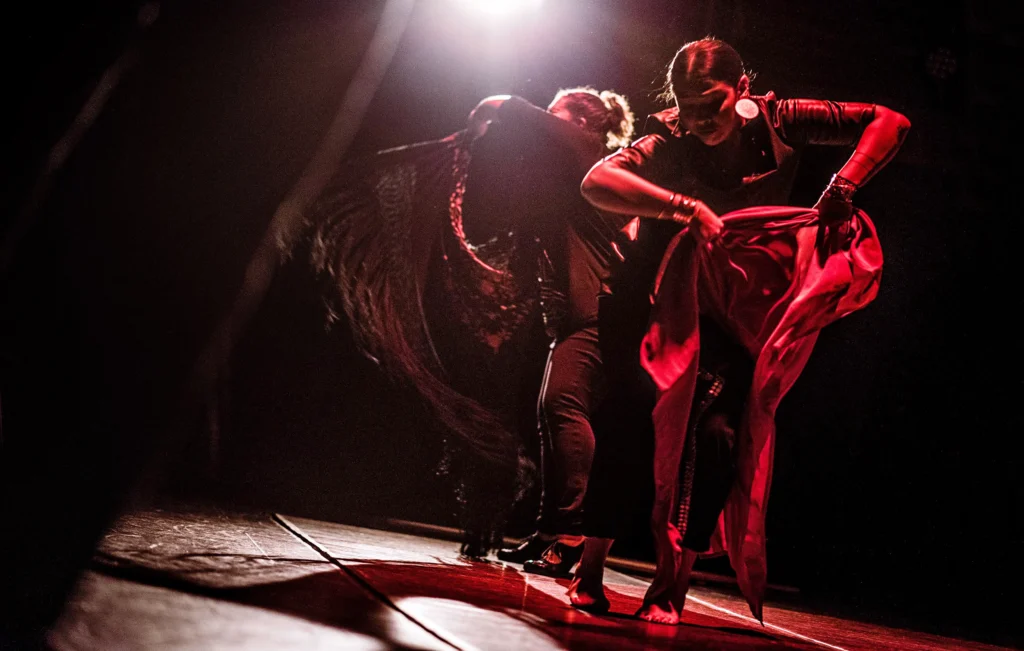
The first time all three gathered as a group was for a publicity-photo shoot for the piece they hadn’t begun rehearsing for yet. Still, the vibes flowed. “It was like we were all long-lost friends,” says Guha.
The work they created was a hit, and they were asked to perform it again…and again. “People want to see virtuosity in music and rhythm that doesn’t include machismo and competition,” says Guha. By 2018, Soles was back at Dixon Place as artists in residence creating the first iteration of their full-length work Can We Dance Here? That work has since become a calling card, with the latest version taking the stage at The Joyce Theater this January as part of the American Dance Platform.
In the audience of that 2018 run was critic and curator Eva Yaa Asantewaa, who, wowed by their vivacity and generosity as performers, would later commission Soles for Gibney’s Spotlight Series in New York City. “I was completely won over, not only by their individual technical and aesthetic capabilities but also by the seamless, joyful way they blended these discrete percussive dance styles and energies,” she says.
Experimentation and Negotiation
In Soles’ work, the dancers sometimes “pass the mic” back and forth, and sometimes dance in unison. But much of the magic happens when they each tackle the same rhythm in their own style, showcasing just how many similarities live within their differences. “We hear music very similarly often, but the way we physically execute the step is very different,” Rosales says. To get a better sense of each other’s weight distribution, the three will sometimes put on each other’s shoes, or Guha’s ghungroo ankle bells, and do traditional warm-ups in each other’s forms.
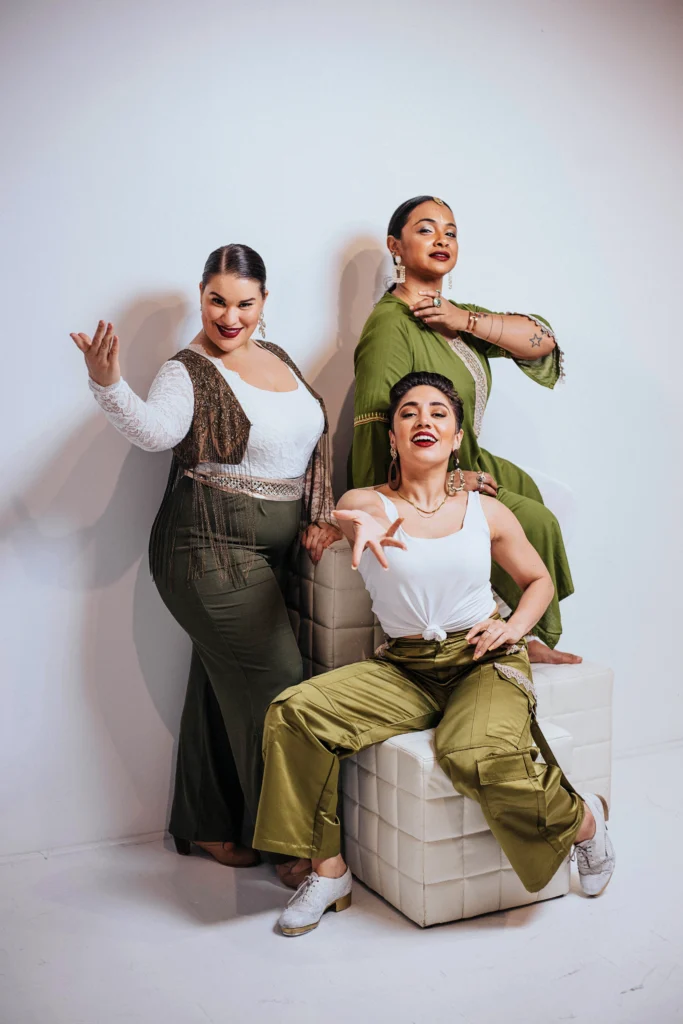
Choreographing is a constant negotiation—with each other, and with how they represent their forms. “We have a Boricua from Connecticut doing tap dance. We have a Mexican Jew who grew up on the Lower East Side doing flamenco. We have a Bengali American who’s learning a North Indian classical dance form in New Jersey,” says Guha. “Are we even allowed to make these artistic decisions? And when do we move forward with and without blessings, and when do we experiment in good faith?” Those questions are part of what informed the title of Can We Dance Here? (The other part is more literal: The trio has often been offered residencies, but told they couldn’t make noise and wouldn’t have a percussive floor.)
All three are very aware that work in historically marginalized forms must be done with integrity. “Even when we have choreographic disagreements, we’re like, ‘Well, why do you feel like that?’ And then we end up having an hour-long conversation about history and why this step is this way,” says Castro.
Yes, They Can Dance Here
Today, Soles also includes three live musicians. They’re treated as both a band and a dance group, which can open up opportunities at many types of venues but can also sometimes mean performing on small stages with amazing sound quality but little space to move. Now, with a 2023 Bessie nomination for Outstanding Breakout Choreographer and rave reviews in The New York Times, they’re hoping to get the best of both worlds soon. This year, the group is wrapping up the final performances of Can We Dance Here? and working on a new feature-length work to premiere in 2025.
They’ve stopped asking for permission to dance because, wherever they are, they know they’ll find a way to do it. “Even when we wait for the train to go back home, we’ll hear the subway and we’ll just start clapping,” says Rosales. “And now we’re jamming and stomping and doing vocals to the sound of the train going by. That’s how we hang out.”
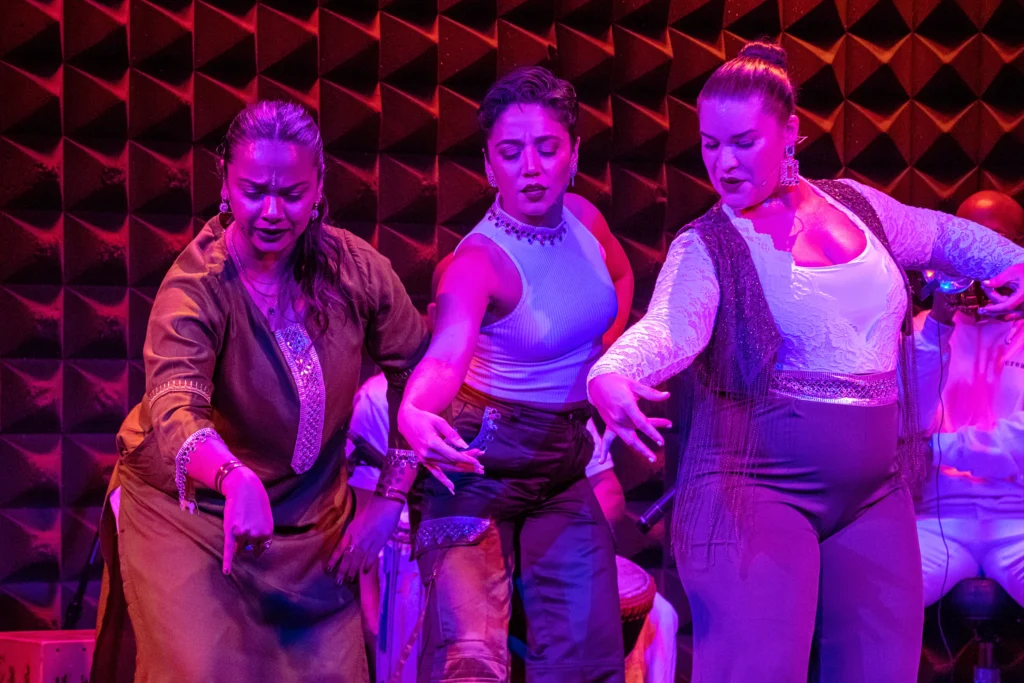
Meet the Trio: Amanda Castro
When people ask Amanda Castro what kind of dancer she is, she likes to tell them “I’m a storyteller.”
She could also say she was that BFA student who choreographed tap dance numbers at the experimental California Institute of the Arts, even after the dean told her not to. Or that she followed four years at Urban Bush Women with stints in a regional production of In the Heights and as Anita in a tour of West Side Story. Or that she now works with heavy-hitting tap dance stars like Ayodele Casel, Dormeshia, Jason Samuels Smith, Jared Grimes, Caleb Teicher, and others. She could mention being one of Dance Magazine’s “25 to Watch” in 2023, and winning a Bessie for Outstanding Performer later that year.
But she sticks with what she sees as her mission as a dancer: to tell stories. “Yes, there are different languages, which are the different styles of dance,” she says. “But I’m here to provide a service to the people.”
Meet the Trio: Brinda Guha
Collaboration has long driven Brinda Guha’s work. It’s even why she fell in love with kathak itself. “I realized how kathak was a confluence of Hindu and Muslim cultures and religions, how it exemplifies how people actually work together and live together and express together and make music together,” she says.
Today, in addition to her work as a dancer and company manager with Soles of Duende, Guha is the artistic director of contemporary Indian dance ensemble Kalamandir Dance Company, curator of arts showcase Wise Fruit NYC, and senior producing coordinator for Dance/NYC. Her main goals are to investigate what makes any art form contemporary and to work from a place that’s driven by the feminine divine, whether in the exploration of contemporary Indian dance in her personal dance practice or through collaboration.
To better understand the essential elements of dance, she’s sought out practitioners from other forms. It’s why she first decided to collaborate with Arielle Rosales. “There was this dialogue around where our personal styles found a way to speak to each other cohesively, and when they were in dissonance,” Guha says. That dialogue has only grown deeper through her work in Soles.
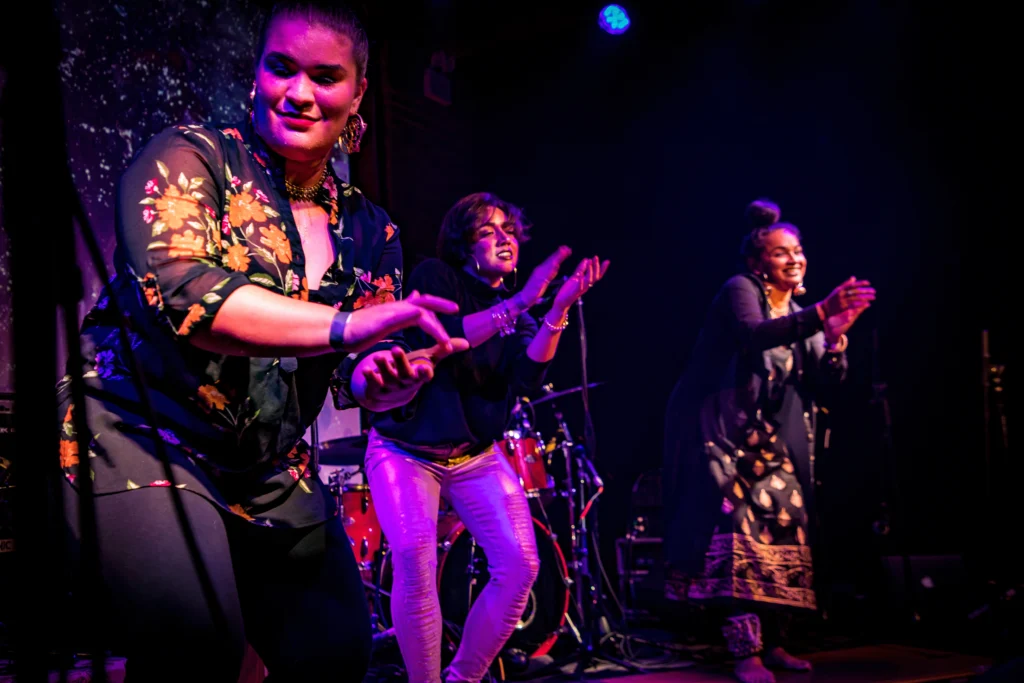
Meet the Trio: Arielle Rosales
On her website, Arielle Rosales calls herself a “social engagement performing artist.” It was a term she chose, she says, because she could never find the right words to describe her work: “Just saying ‘flamenco dancer’ felt inaccurate.”
In addition to pushing the boundaries of flamenco, Rosales is a percussionist with an all-woman Afro-Brazilian band, and she once ran a multicultural dance school in East Harlem called House of Duende (which hosted some of Soles of Duende’s first rehearsals and led to the group’s name). The phrase “social engagement” also felt like it better encompassed her love of engaging directly with the audience through site-specific work and the lecture-demonstrations she does with Flamenco Vivo Carlota Santana.
Still, Rosales admits that the term initially came out of a place of fear that her experimentations with the form meant she didn’t fully qualify as a flamenco dancer. But that’s changed. “Over the seven years with Soles, because we are so intentional about what traditional things we’re using, and when we’re breaking the rules, in that journey of integrity, now I will call myself a flamenco dancer fully,” she says. “I don’t feel any more like anyone can take that away from me.”
